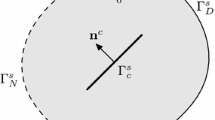Abstract
Molecular dynamics is applicable only to an extremely small region of simulation. In order to simulate a large region, it is necessary to combine molecular dynamics with continuum mechanics. Therefore, we propose a new model where molecular dynamics is combined with micromechanics. In this model, we apply molecular dynamics to the crack tip region and apply micromechanics to the surrounding region. Serious problems exist at the boundary between the two regions. In this study, we manage to solve these problems, and make possible the simulation of the process of crack propagation at the atomic level. In order to examine the validity of this model, we use α-iron for simulation. If the present model is valid, stress and displacement should vary continuously across the boundary between the molecular dynamics region and the micromechanics region. Our model exhibits just such behavior.
Similar content being viewed by others
References
Cheung, K.S. and Yips, S. (1990). Brittle-Ductile transition in intrinsic fracture behavior of crystals. Physical Review Letters 65, 2804.
Chou, Y.T. (1967). Dislocation pile-ups against a locked dislocation of different Burgers vector. Journal of Applied Physics 38, 2080.
deCelis, B., Argon, A.S. and Yip, S. (1983). Molecular dynamics simulation of crack tip process in alpha-iron and copper. Journal of Applied Physics 54, 4864.
Eshelby, J.D. (1957). The determination of the elastic field of an ellipsoidal inclusion, and related problems. Proceedings, Royal Society London A241, 376.
Eshelby, J.D., Frank, F.C. and Nabarro, F.R.N. (1951). The equilibrium of linear arrays of dislocations. Philosophical Magazine 42, 351.
Hirth, J.P., Hoagland, R.G. and Gehlen, P.C. (1974). The interaction between line force arrays and planar cracks. International Journal of Solids and Structures 10, 977.
Johnson, R.A. (1964). Interstitials and vacancies in α-iron. Physical Review 134, 1329.
Kanninen, M.F. and Gehlen, P.C. (1971). Atomic simulation of crack extension in BCC iron. International Journal of Fracture Mechanics 7, 471.
Kitagawa, H., Nakatani, A. and Shibutani, Y. (1994). Molecular dynamics study of crack processes associated with dislocation nucleated at the tip. Materials Science and Engineering A 176, 263.
Kohlhoff, S., Gumbsch, P. and Fichmeister, H.F. (1991). Crack propagation in b.c.c. crystals studied with a combined finite-element and atomistic model. Philosophical Magazine 64, 851.
Kohlhoff, S., Schmauder, S. and Gumbsch, P. (1988), A new method for coupled elastic-atomistic modeling, Edited by V. Vitek and D.J. Srolovitz, Large Atomistic Simulation of Materials — Beyond Pair Potentials —, Plenum Press, 411.
Lekhnitski, S.G. (1968). Anisotropic plates. Gordon and Breach.
Mullins, M. (1982). Molecular dynamics simulation of propagating cracks. Scripta Metallurgica 16, 663.
Mullins, M. and Dokanish, F. (1982). Simulation of the (001) plane crack in α-iron employing a new boundary scheme. Philosophical Magazine 46, 771.
Nisitani, H. (1978). Solutions of notch problems by body force method. Mechanics of Fracture 5, Noordhoff International Publishing, Chapter 1.
Sinclair, J.E., Gehlen, P.C., Hoagland, R.G. and Hirth, J.P. (1978). Flexible boundary conditions and nonlinear geometric effects in atomic dislocation modeling. Journal of Applied Physics 49, 3890.
Weertman, J. and Weertman, J.R. (1964). Elementary dislocation theory. The Macmillan Company.
Weiner, J.H. and Pear, M. (1975). Crack and dislocation propagation in an idealized crystal model. Journal of Applied Physics 46, 2398.
Author information
Authors and Affiliations
Rights and permissions
About this article
Cite this article
Noguchi, H., Furuya, Y. A method of seamlessly combining a crack tip molecular dynamics enclave with a linear elastic outer domain in simulating elastic–plastic crack advance. International Journal of Fracture 87, 309–329 (1997). https://doi.org/10.1023/A:1007442003884
Issue Date:
DOI: https://doi.org/10.1023/A:1007442003884




